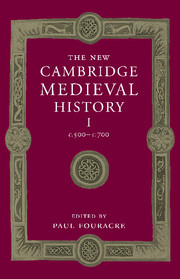Book contents
- Frontmatter
- Introduction: the history of Europe 500–700
- 1 The later Roman Empire
- 2 The Barbarian invasions
- 3 The sources and their interpretation
- PART I THE SIXTH CENTURY
- 4 The Eastern Empire in the sixth century
- 5 The Byzantines in the West in the sixth century
- 6 Ostrogothic Italy and the Lombard invasions
- 7 The formation of the Sueve and Visigothic kingdoms in Spain
- 8 Merovingian Gaul and the Frankish conquests
- 9 The Celtic kingdoms
- 10 The earliest Anglo-Saxon kingdoms
- PART II THE SEVENTH CENTURY
- PART III THEMES AND PROBLEMS
- List of Primary sources
- Bibliography of secondary works arranged by chapter
- Index
- Frontispiece"
- Plate section"
- Map 3 Gaul/Francia in the sixth and seventh centuries"
- References
4 - The Eastern Empire in the sixth century
from PART I - THE SIXTH CENTURY
Published online by Cambridge University Press: 28 March 2008
- Frontmatter
- Introduction: the history of Europe 500–700
- 1 The later Roman Empire
- 2 The Barbarian invasions
- 3 The sources and their interpretation
- PART I THE SIXTH CENTURY
- 4 The Eastern Empire in the sixth century
- 5 The Byzantines in the West in the sixth century
- 6 Ostrogothic Italy and the Lombard invasions
- 7 The formation of the Sueve and Visigothic kingdoms in Spain
- 8 Merovingian Gaul and the Frankish conquests
- 9 The Celtic kingdoms
- 10 The earliest Anglo-Saxon kingdoms
- PART II THE SEVENTH CENTURY
- PART III THEMES AND PROBLEMS
- List of Primary sources
- Bibliography of secondary works arranged by chapter
- Index
- Frontispiece"
- Plate section"
- Map 3 Gaul/Francia in the sixth and seventh centuries"
- References
Summary
The beginning of the century saw Anastasius (491–518) on the imperial throne, ruling an empire that was still thought of as essentially the Roman Empire, coextensive with the world of the Mediterranean, however unrealistic such a view seems to modern historians, who have the benefit of hindsight. Although Anastasius ruled from Constantinople, ‘New Rome’, over what we call the ‘Eastern Empire’, the Western Empire having been carved up into the ‘barbarian kingdoms’, this perspective is ours, not theirs. Through the conferring of titles in the gift of the emperor, and the purchasing of alliances with the wealth of the Empire – wealth that was to dwarf the monetary resources of the West for centuries to come – the barbarian kings could be regarded as client kings, acknowledging the suzerainty of the emperor in New Rome, and indeed the barbarian kings were frequently happy to regard themselves in this light. The discontinuation of the series of emperors in the West, with the deposition of Romulus Augustulus in 476, was regarded by very few contemporaries as a significant event: the notion that East and West should each have its own emperor was barely of a century’s standing, and the reality of barbarian military power in the West, manipulated from Constantinople, continued, unaffected by the loss of an ‘emperor’ based in the West.
- Type
- Chapter
- Information
- The New Cambridge Medieval History , pp. 91 - 117Publisher: Cambridge University PressPrint publication year: 2005
References
- 1
- Cited by



